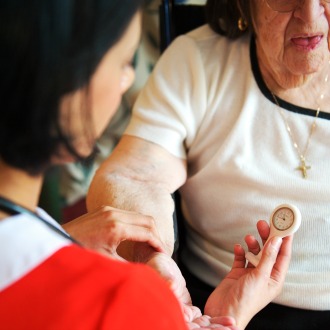GPs have been advised to to offer tailored care plans to people with two or more long-term conditions and consider stopping all treatments with ‘limited benefit’, by new NICE guidelines on multimorbidity published today.
The final guidance – largely unchanged from the draft version published at the end of March – urges GPs to draw up individual care plans for patients with two or more conditions – particularly elderly and frail people, and those taking 15 or more medications regularly.
The guidelines lay out how GPs should review medications and provide a ‘database of treatment effects’ to help weigh up the pros and cons of individual drugs.
NICE multimorbidity guidance – key recommendations
This guidance begins a change in the way we practice
The long-awaited guidelines are designed to help GPs manage patients with multimorbidity and have been under discussion since 2012, amid concerns that the plethora of single-condition guidance was unhelpful for busy GPs and was driving an epidemic of overtreatment.
GP experts welcomed the final publication – which has been in the pipeline for more than four years – but cautioned that GPs were not adequately resourced to carry out the extra work involved in developing individual plans and reviewing medications.
Professor Bruce Guthrie, professor of primary care medicine at the University of Dundee and chair of the group that developed the guidelines, said: ‘It’s not unusual for patients to be on lots of different medicines, to be taken at different times of the day for each of their conditions. The new guideline highlights the need for clinicians to discuss with their patients what the benefits and unwanted side-effects of drugs or treatments are.
‘A decision on what treatment is best for the patient, based on their wishes, can then be made – and this could lead to stopping treatment if appropriate.’
Dr Andrew Green, chair of the GPC clinical and prescribing subcommittee, said he was ‘delighted’ NICE had produced the guideline and that ‘hopefully, this will empower the more timid among us to adapt our treatments to our patient, and not force our patients into the guidelines’.
Dr John Cosgrove, RCGP council member and a GP in Cheshire, agreed, saying it ‘is good to see acknowledgment of the medical complexity of so many of our patients’ and that ‘GPs as expert medical generalists have the ideal skill set to manage multimorbidity in this way’.
However, he cautioned that this kind of approach ‘is increasingly difficult for us to fit into the available time’.
Dr Cosgrove added: ‘What is urgently needed is more resources into primary care to allow us more time for each patient.’
Dr Shaba Nabi, Avon LMC representative and a GP in Bristol, said the guidance was ‘a good document that is bread and butter for any good GP’ but that it was limited by the current lack of ‘capacity and GP continuity’.
Dr Nabi also cautioned that the guidelines make ‘no reference to exception reporting for QOF, which is essential to reduce the treatment burden in these patients’ and offered ‘little to empower patients to direct their personal goals’.
The long journey to NICE multimorbidity guidelines
GPs have been waiting for NICE guidelines on multimorbidity for several years, after NICE chiefs admitted that single-disease guidelines were unhelpful to GPs managing increasingly complex patients in their daily practice.
Leading GPs have warned existing guidelines are partly to blame for an epidemic of over-treatment, and NICE advisors admitted that it is too difficult for GPs to dig out the real benefits and harms of treatments from individual guidelines recommendations.
Current NICE chair Professor David Haslam – a former GP – has repeatedly reassured GPs he is commited to making guidelines more relevant to GPs, with the multimorbidity guidance a key step towards realising this aim.
Pulse October survey
Take our July 2025 survey to potentially win £1.000 worth of tokens

Visit Pulse Reference for details on 140 symptoms, including easily searchable symptoms and categories, offering you a free platform to check symptoms and receive potential diagnoses during consultations.











